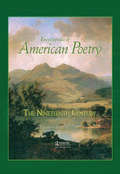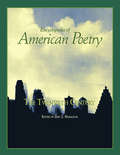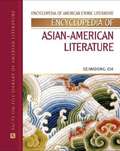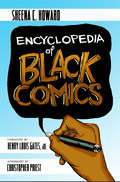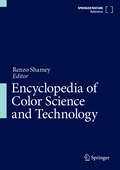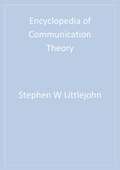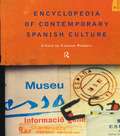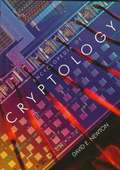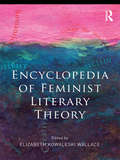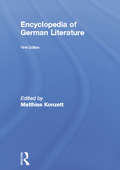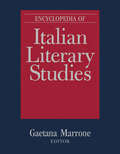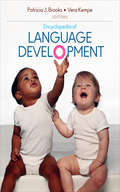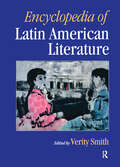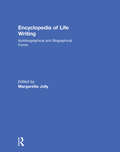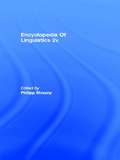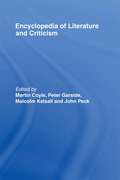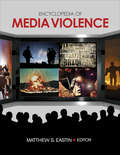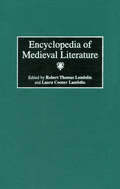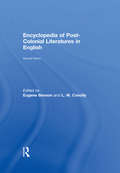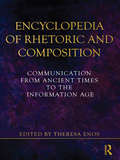- Table View
- List View
Encyclopedia of American Poetry: The Nineteenth Century
by Eric L. HaralsonWith contributions from over 100 scholars, the Encyclopedia of American Poetry: The Nineteenth Centry provides essays on the careers, works, and backgrounds of more than 100 nineteenth-century poets. It also provides entries on specialized categories of twentieth-century verse such as hymns, folk ballads, spirituals, Civil War songs, and Native American poetry. Besides presenting essential factual information, each entry amounts to an in-depth critical essay, and includes a bibliography that directs readers to other works by and about a particular poet.
Encyclopedia of American Poetry: The Twentieth Century
by Eric L. HaralsonThe Encyclopedia of American Poetry: The Twentieth Century contains over 400 entries that treat a broad range of individual poets and poems, along with many articles devoted to topics, schools, or periods of American verse in the century. Entries fall into three main categories: poet entries, which provide biographical and cultural contexts for the author's career; entries on individual works, which offer closer explication of the most resonant poems in the 20th-century canon; and topical entries, which offer analyses of a given period of literary production, school, thematically constructed category, or other verse tradition that historically has been in dialogue with the poetry of the United States.
Encyclopedia of Asian American Literature
by Seiwoong OhThis encyclopedia, meant for high school and college students, contains 337 entries on Asian-American writers and their major literary works, with an emphasis on fiction, poetry, and drama. Oh (English, Rider U.) includes some Canadian authors such as Joy Kogawa for their importance to the literary canon. Writers and works were chosen to meet the criteria teachers use when selecting them: aesthetic value, historical significance, teachability, and commercial availability. These include Maxine Hong Kingston, Amy Tan, Henry Hwang, Ha Jin, Chang-rae Lee, Khaled Hosseini, writers of detective fiction such as Leonard Chang, and young adult authors such as Linda Sue Park. Entries, which were written by specialists based in the US, Asia, and Europe, consist of information about each author, synopses, and critical analyses. Some memoirs, screenwriting, nonfiction, and experimental writings have been included. Annotation ©2007 Book News, Inc., Portland, OR (booknews.com)
Encyclopedia of Black Comics
by Christopher Priest Sheena C. HowardThe Encyclopedia of Black Comics, focuses on people of African descent who have published significant works in the United States or have worked across various aspects of the comics industry. The book focuses on creators in the field of comics: inkers, illustrators, artists, writers, editors, Black comic historians, Black comic convention creators, website creators, archivists and academics—as well as individuals who may not fit into any category but have made notable achievements within and/or across Black comic culture.
Encyclopedia of Color Science and Technology
by Renzo ShameyThis fully revised and expanded 2nd edition provides a single authoritative resource describing the concepts of color and the application of color science across research and industry. Significant changes for the 2nd edition include: New and expanded sections on color engineeringMore entries on fundamental concepts of color science and color termsMany additional entries on specific materialsFurther material on optical concepts and human visual perceptionAdditional articles on organisations, tools and systems relevant to colorA new set of entries on 3D presentation of color In addition, many of the existing entries have been revised and updated to ensure that the content of the encyclopedia is current and represents the state of the art. The work covers the full gamut of color: the fundamentals of color science; the physics and chemistry; color as it relates to optical phenomena and the human visual system; and colorants and materials. The measurement of color is described through entries on colorimetry, color spaces, color difference metrics, color appearance models, color order systems and cognitive color. The encyclopedia also has extensive coverage of applications throughout industry, including color imaging, color capture, display and printing, and descriptions of color encodings, color management, processing color and applications relating to color synthesis for computer graphics are included. The broad scope of the work is illustrated through entries on color in art conservation, color and architecture, color and education, color and culture, and biographies of some of the key figures involved in color research throughout history. With over 250 entries from color science researchers across academia and industry, this expanded 2nd edition of the Encyclopedia of Color Science and Technology remains the most important single resource in color science.
Encyclopedia of Communication Theory
by Karen A. Foss Dr Stephen W. LittlejohnWith more than 300 entries, these two volumes provide a one-stop source for a comprehensive overview of communication theory, offering current descriptions of theories as well as the background issues and concepts that comprise these theories. This is the first resource to summarize, in one place, the diversity of theory in the communication field.Key ThemesApplications and ContextsCritical OrientationsCultural OrientationsCybernetic and Systems OrientationsFeminist OrientationsGroup and Organizational ConceptsInformation, Media, and Communication TechnologyInternational and Global ConceptsInterpersonal ConceptsNon-Western OrientationsParadigms, Traditions, and SchoolsPhilosophical OrientationsPsycho-Cognitive OrientationsRhetorical OrientationsSemiotic, Linguistic, and Discursive OrientationsSocial/Interactional OrientationsTheory, Metatheory, Methodology, and Inquiry
Encyclopedia of Contemporary Spanish Culture (Encyclopedias of Contemporary Culture)
by Eamonn RodgersSome 750 alphabetically-arranged entries provide insights into recent cultural and political developments within Spain, including the cultures of Catalonia, Galicia and the Basque country. Coverage spans from the end of the Civil War in 1939 to the present day, with emphasis on the changes following the demise of the Franco dictatorship in 1975.Entries range from shorter, factual articles to longer overview essays offering in-depth treatment of major issues. Culture is defined in its broadest sense. Entries include:*Antonio Gaudí * science * Antonio Banderas * golf * dance * education * politics * racism * urbanization This Encyclopedia is essential reading for anyone interested in Spanish culture. It provides essential cultural context for students of Spanish, European History, Comparative European Studies and Cultural Studies.
Encyclopedia of Cryptology
by David E. NewtonAimed at a general audience- perhaps high school students and above- rather than the sophisticated math and computer specialists who deal with the subject at a detailed level. The history, uses, significance, terminology and acronyms, and important personages and events connected with secret writing are explained in 550 entries, each with cross-references and most with suggestions for further reading. Includes an annotated bibliography.
Encyclopedia of Erotic Literature
by John Phillips GaThe Encyclopedia of Erotic Literature is a two-volume work that contains some 540 entries on erotic literature on an international scale. The Encyclopedia has an unprecedented scope, the first scholarly reference resource to bring the field together in all its fascinating variety. The entries examine the history of the literature in different countries and languages from classical antiquity to the present day, individual writers from around the world (not all of them necessarily known as specialist writers of erotic literature), significant works, genres and critical approaches, and general themes pertinent to erotic literature (nudity, prostitution, etc.). The definition of erotic literature is broad, encompassing all the material recognized in the study of the field: not just fiction in all genres (novels, poetry, short stories, drama), but also essays, autobiographies, treatises and sex manuals from different cultures. This Encyclopedia deals with sexually explicit texts characterized by sexual representations and suggestions. All types of sexuality are included. For more information about the title and the editors, go to: http://www.londonmet.ac.uk/news/latest-news/erotic-encyclopedia-edited-by-london-met-professor.cfm/
Encyclopedia of Feminist Literary Theory
by Elizabeth Kowaleski WallaceFrom the cutting edge to the basics The latest advances as well as the essentials of feminist literary theory are at your fingertips as soon as you open this brand-new reference work. It features-in quick and convenient form-precise definitions of important terms and concise summaries of the salient ideas of critics working in the field who have made significant contributions to feminist literary studies, and points out how a feminist perspective has affected the development of emerging ideas and intellectual practices. Every effort has been made to include as many feminist thinkers as possible. Expanded coverage of key subjects Overview entries cover topics ranging from creativity, beauty, and eroticism topornography, violence, and war, with a thorough exploration of the major theoretical points of feminist literary approaches and concerns. In addition, entries organized around literary periods and fields, such as medieval studies, Shakespeare and Romanticism survey subjects in the framework of feminist literary theory and feminist concerns. Shows how feminist ideas have shaped literary theory The Encyclopedia gathers in one place all the key words, topics, proper names, and critical terminology of feminist literary theory. Emphasis throughout is on usage in the United States and Great Britain since the l970s. Each entry is accompanied by a bibliography that is a point of departure for further research. A key advantage of this Encyclopedia is that it amasses bibliographic references for so many important and often-cited works within a single volume. Instructors especially will find this information invaluable in the preparation of course material. Special FeaturesOffers precise contemporary definitions of all important critical terms * Summarizes the salient ideas of key literary critics * Overviews cover major theoretical issues * Entries on periods and fields survey feminist contributions * Emphasizes terminology that has evolved since the l970s * Indexes proper names, subjects, key words, and related topics
Encyclopedia of German Literature
by Matthias KonzettFirst Published in 2000. Routledge is an imprint of Taylor & Francis, an informa company.
Encyclopedia of Humor Studies
by Salvatore I. AttardoThe Encyclopedia of Humor: A Social History explores the concept of humor in history and modern society in the United States and internationally. This work’s scope encompasses the humor of children, adults, and even nonhuman primates throughout the ages, from crude jokes and simple slapstick to sophisticated word play and ironic parody and satire. As an academic social history, it includes the perspectives of a wide range of disciplines, including sociology, child development, social psychology, life style history, communication, and entertainment media. Readers will develop an understanding of the importance of humor as it has developed globally throughout history and appreciate its effects on child and adult development, especially in the areas of health, creativity, social development, and imagination. This two-volume set is available in both print and electronic formats. Features & Benefits: The General Editor also serves as Editor-in-Chief of HUMOR: International Journal of Humor Research for The International Society for Humor Studies. The book’s 335 articles are organized in A-to-Z fashion in two volumes (approximately 1,000 pages). This work is enhanced by an introduction by the General Editor, a Foreword, a list of the articles and contributors, and a Reader’s Guide that groups related entries thematically. A Chronology of Humor, a Resource Guide, and a detailed Index are included. Each entry concludes with References/Further Readings and cross references to related entries. The Index, Reader’s Guide themes, and cross references between and among related entries combine to provide robust search-and-browse features in the electronic version. This two-volume, A-to-Z set provides a general, non-technical resource for students and researchers in such diverse fields as communication and media studies, sociology and anthropology, social and cognitive psychology, history, literature and linguistics, and popular culture and folklore.
Encyclopedia of Humor Studies
by Salvatore I. AttardoThe Encyclopedia of Humor: A Social History explores the concept of humor in history and modern society in the United States and internationally. This work’s scope encompasses the humor of children, adults, and even nonhuman primates throughout the ages, from crude jokes and simple slapstick to sophisticated word play and ironic parody and satire. As an academic social history, it includes the perspectives of a wide range of disciplines, including sociology, child development, social psychology, life style history, communication, and entertainment media. Readers will develop an understanding of the importance of humor as it has developed globally throughout history and appreciate its effects on child and adult development, especially in the areas of health, creativity, social development, and imagination. This two-volume set is available in both print and electronic formats. Features & Benefits: The General Editor also serves as Editor-in-Chief of HUMOR: International Journal of Humor Research for The International Society for Humor Studies. The book’s 335 articles are organized in A-to-Z fashion in two volumes (approximately 1,000 pages). This work is enhanced by an introduction by the General Editor, a Foreword, a list of the articles and contributors, and a Reader’s Guide that groups related entries thematically. A Chronology of Humor, a Resource Guide, and a detailed Index are included. Each entry concludes with References/Further Readings and cross references to related entries. The Index, Reader’s Guide themes, and cross references between and among related entries combine to provide robust search-and-browse features in the electronic version. This two-volume, A-to-Z set provides a general, non-technical resource for students and researchers in such diverse fields as communication and media studies, sociology and anthropology, social and cognitive psychology, history, literature and linguistics, and popular culture and folklore.
Encyclopedia of Italian Literary Studies
by Luca Somigli Gaetana Marrone Paolo PuppaThe Encyclopedia of Italian Literary Studies is a two-volume reference book containing some 600 entries on all aspects of Italian literary culture. It includes analytical essays on authors and works, from the most important figures of Italian literature to little known authors and works that are influential to the field. The Encyclopedia is distinguished by substantial articles on critics, themes, genres, schools, historical surveys, and other topics related to the overall subject of Italian literary studies. The Encyclopedia also includes writers and subjects of contemporary interest, such as those relating to journalism, film, media, children's literature, food and vernacular literatures. Entries consist of an essay on the topic and a bibliographic portion listing works for further reading, and, in the case of entries on individuals, a brief biographical paragraph and list of works by the person. It will be useful to people without specialized knowledge of Italian literature as well as to scholars.
Encyclopedia of Language Development
by Dr Patricia J. Brooks Vera KempeThe progression from newborn to sophisticated language user in just a few short years is often described as wonderful and miraculous. What are the biological, cognitive, and social underpinnings of this miracle? What major language development milestones occur in infancy? What methodologies do researchers employ in studying this progression? Why do some become adept at multiple languages while others face a lifelong struggle with just one? What accounts for declines in language proficiency, and how might such declines be moderated? Despite an abundance of textbooks, specialized monographs, and a couple of academic handbooks, there has been no encyclopedic reference work in this area--until now. The Encyclopedia of Language Development covers the breadth of theory and research on language development from birth through adulthood, as well as their practical application. Features: This affordable A-to-Z reference includes 200 articles that address such topic areas as theories and research tradition; biological perspectives; cognitive perspectives; family, peer, and social influences; bilingualism; special populations and disorders; and more. All articles (signed and authored by key figures in the field) conclude with cross reference links and suggestions for further reading. Appendices include a Resource Guide with annotated lists of classic books and articles, journals, associations, and web sites; a Glossary of specialized terms; and a Chronology offering an overview and history of the field. A thematic Reader’s Guide groups related articles by broad topic areas as one handy search feature on the e-Reference platform, which includes a comprehensive index of search terms. Available in both print and electronic formats, Encyclopedia of Language Development is a must-have reference for researchers and is ideal for library reference or circulating collections.
Encyclopedia of Latin American Literature
by Verity SmithA comprehensive, encyclopedic guide to the authors, works, and topics crucial to the literature of Central and South America and the Caribbean, the Encyclopedia of Latin American Literature includes over 400 entries written by experts in the field of Latin American studies. Most entries are of 1500 words but the encyclopedia also includes survey articles of up to 10,000 words on the literature of individual countries, of the colonial period, and of ethnic minorities, including the Hispanic communities in the United States. Besides presenting and illuminating the traditional canon, the encyclopedia also stresses the contribution made by women authors and by contemporary writers. Outstanding Reference Source Outstanding Reference Book
Encyclopedia of Life Writing: Autobiographical and Biographical Forms
by Margaretta JollyFirst published in 2001. Routledge is an imprint of Taylor & Francis, an informa company.
Encyclopedia of Linguistics
by Philipp StraznyUtilizing a historical and international approach, this valuable two-volume resource makes even the more complex linguistic issues understandable for the non-specialized reader. Containing over 500 alphabetically arranged entries and an expansive glossary by a team of international scholars, the Encyclopedia of Linguistics explores the varied perspectives, figures, and methodologies that make up the field.
Encyclopedia of Literature and Criticism (Routledge Companion Encyclopedias)
by John Peck Martin Coyle Malcolm Kelsall Peter GarsideThis Encyclopedia is the most comprehensive guide yet both to the nature and content of literature, and to literary criticism. In ninety essays by leading international critics and scholars, the volume covers both traditional topics such as literature and history, poetry, drama and the novel, and also newer topics such as the production and reception of literature. Current critical ideas are clearly and provocatively discussed, while the volume's arrangement reflects in a dynamic way the rich diversity of contemporary thinking about literature.Each essay seeks to provide the reader with a clear sense of the full significance of its subject as well as guidance on further reading.An essential work of reference, The Encyclopedia of Literature and Criticism is a stimulating guide to the central preoccupations of contemporary critical thinking about literature.Special Features* Clearly written by scholars and critics of international standing for readers at all levels in many disciplines* In-depth essays covering all aspects, traditional and new, of literary studies past and present* Useful cross-references within the text, with full bibliographical references and suggestions for further reading* Single index of authors, terms, topics
Encyclopedia of Media Violence: One-Volume Set
by Matthew S. EastinVia 134 signed entries, this encyclopedia provides students, researchers, and the general public with an accessible, comprehensive, and well-balanced eviddence-based examination of theory, research and debates related to media violence. Entries conclude with Cross-References and Suggestions for Further Readings to guide users to related entries and resources for further research, and a thematic Reader’s Guide in the front matter groups related entries by topic to make it easier for users to locate related entries of interest.
Encyclopedia of Media Violence: One-Volume Set
by Matthew S. EastinVia 134 signed entries, this encyclopedia provides students, researchers, and the general public with an accessible, comprehensive, and well-balanced eviddence-based examination of theory, research and debates related to media violence. Entries conclude with Cross-References and Suggestions for Further Readings to guide users to related entries and resources for further research, and a thematic Reader’s Guide in the front matter groups related entries by topic to make it easier for users to locate related entries of interest.
Encyclopedia of Medieval Literature
by Robert Thomas Lambdin Laura Cooner LambdinThis reference is a comprehensive guide to literature written 500 to 1500 A.D., a period that gave rise to some of the world's most enduring and influential works, such as Dante's Commedia, Geoffrey Chaucer's The Canterbury Tales, and a large body of Arthurian lore and legend. While its emphasis is upon medieval English texts and society, this reference also covers Islamic, Hispanic, Celtic, Mongolian, Germanic, Italian, and Russian literature and Middle Age culture. Longer entries provide thorough coverage of major English authors such as Chaucer and Sir Thomas Malory, and of genre entries, such as drama, lyric, ballad, debate, saga, chronicle, and hagiography. Shorter entries examine particular literary works; significant kings, artists, explorers, and religious leaders; important themes, such as courtly love and chivalry; and major historical events, such as the Crusades. Each entry concludes with a brief biography. The volume closes with a list of the most valuable general works for further reading.
Encyclopedia of Post-Colonial Literatures in English
by L. W. Conolly Eugene BensonPost-Colonial Literatures in English, together with English Literature and American Literature, form one of the three major groupings of literature in English, and, as such, are widely studied around the world. Their significance derives from the richness and variety of experience which they reflect. In three volumes, this Encyclopedia documents the history and development of this body of work and includes original research relating to the literatures of some 50 countries and territories. In more than 1,600 entries written by more than 600 internationally recognized scholars, it explores the effect of the colonial and post-colonial experience on literatures in English worldwide.
Encyclopedia of Postmodernism
by Victor E. Taylor Charles E. WinquistThe Encyclopedia of Postmodernism provides comprehensive and authoritative coverage of academic disciplines, critical terms and central figures relating to the vast field of postmodern studies. With three cross-referenced sections, the volume is easily accessible to readers with specialized research agendas and general interests in contemporary cultural, historical, literary and philosophical issues.Since its inception in the 1960s, postmodernism has emerged as a significant cultural, political and intellectual force that many scholars would argue defines our era. Postmodernism, in its various configurations, has consistently challenged concepts of selfhood, knowledge formation, aesthetics, ethics, history and politics. This Encyclopedia offers a wide-range of perspectives on postmodernism that illustrates the plurality of this critical concept that is so much part of our current intellectual debates. In this regard, the volume does not adhere to a single definition of postmodernism as much as it documents the use of the term across a variety of academic and cultural pursuits.The Encyclopedia of Postmodernism, it must be noted, resists simply presenting postmodernism as a new style among many styles occuring in the post-disciplinary academy. Documenting the use of the term acknowledges that postmodernism has a much deeper and long-lasting effect on academic and cultural life. In general, the volume rests on the understanding that postmodernism is not so much a style as it is an on-going process, a process of both disintegration and reformation.
Encyclopedia of Rhetoric and Composition: Communication from Ancient Times to the Information Age
by Theresa EnosThis reference guide surveys the field, covering rhetoric's principles, concepts, applications, practical tools, and major thinkers. Drawing on the scholarship and expertise of 288 contributors, the Encyclopedia presents a long-needed overview of rhetoric and its role in contemporary education and communications, discusses rhetoric's contributions to various fields, surveys the applications of this versatile discipline to the teaching of English and language arts, and illustrates its usefulness in all kinds of discourse, argument, and exchange of ideas.媭
